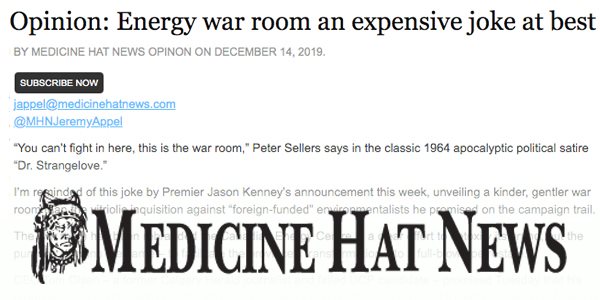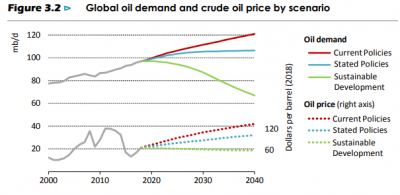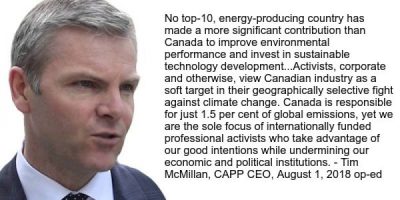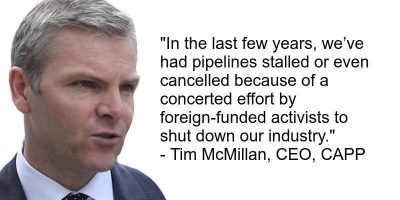
Is it a coincidence the Centre picked on a small city newspaper with no energy reporter? Who will the war room attack next?
After Alberta’s UCP government launched the Canadian Energy Centre a few weeks ago, journalists wondered if they would be a target of Premier Jason Kenney’s energy warriors. As Jeremy Appel discovered Monday, we didn’t have to wait long for an answer.

The education and justice reporter for the Medicine Hat News penned an opinion piece that ran in the Saturday edition. It concluded, “At best, the war room is an expensive joke. At worst, it’s a grave threat to our right to dissent.”
The “energy war room,” as Kenney originally called it, was not amused.
“I just wanted to reach out to let you know that we will provide a response to clarify many of the comments and inaccuracies in Mr. Appel’s column,” Grady Semmens, director of content and external relations for the Centre, informed the paper. “I will have you something on Monday afternoon and would appreciate it if you could run it as an op-ed as quickly as possible.” The newspaper declined comment for this column.
We wondered if the war room adhered to the same standards it applied to Appel’s article and reviewed Energy Centre CEO Tom Olsen’s inaugural column to find out.
Energy war room editorial standards
“At its core, the CEC’s mandate is to create a new, pragmatic, fact-based narrative about Canadian energy,” writes Olsen. “We will reject what is false and promote what is true.” A bold claim, but is it accurate?
Let’s start with his assertion that the Centre will create a new narrative about Canadian energy. Based upon the column, the stories on the website, and a review of the CEC’s Facebook page and Twitter account, the new narrative looks pretty much like the old one, which Energi Media has argued is all about protecting the status quo and insulating Alberta from global and national pressures to change more rapidly.

Globally, the energy transition is getting real. The electrification of transportation, which consumes about two-thirds of oil production, is advancing faster than expected thanks to rapidly falling battery costs. Respected consulting firms like McKinsey and Wood Mackenzie estimate peak oil demand’s arrival between 2025 and 2036.
Change isn’t coming, Alberta, it’s already here.
Nationally, new federal climate regulations are causing considerable consternation in downtown Calgary boardrooms. Prime Minister Justin Trudeau’s election pledge to meet Paris Agreement targets by 2030 and national net-zero emissions by 2050 ratcheted up the concern a few more notches.
For example, the clean fuels standard is set to come into force in 2022. It will require fossil fuel suppliers to reduce the carbon-intensity of diesel, gasoline, and natural gas by 10-12 per cent, lowering national greenhouse gas emissions by 30 megatonnes. The standard will raise the cost at the pump by 1.5 cents per litre in 2025 to 5 cents in 2030. Initially, the Canadian Association of Petroleum Producers (CAPP) wanted upstream oil and gas production exempted from the standard. When that demand didn’t fly with Ottawa, CAPP shifted gears, trying and failing to mobilize public support against the new regulations.
Squeezed by wrenching structural changes to global markets and policy changes at home, several years ago the industry began to push back by fashioning a new narrative, that Alberta is already “world-leading” and that the world needs more Canadian energy.
Olsen and company are simply amplifying that old narrative.
“We know there will be increasing demand globally for oil and gas for decades to come.”
This is blatantly false, at least for crude oil. Credible organizations like the International Energy Agency (IEA) don’t forecast decades into the future. “The IEA doesn’t have a long-term forecast,” economist Tim Gould, who is responsible for energy demand modelling, told Energi Media in July.

Instead, the IEA creates scenarios based upon a set of assumptions. In the Stated Policies scenario, oil consumption grows from 100 million barrels per day today to 106 million barrels per day by 2040, as outlined in the World Energy Outlook 2019. The Sustainable Development scenario, however, sees demand fall to around 65 million barrels per day and prices fall to $20 per barrel.
Which scenario is “true”? None of them.
The energy future is extremely uncertain because technology – like electric vehicles and battery storage – is changing so rapidly. As Kingsmill Bond, an energy transition specialist and financial analyst with Carbon Tracker, told Energi Media in a video interview that there are good arguments for both a quick and a gradual transition.
Claims that “we know” oil demand will grow for decades are simply not accurate. In fact, even taking this position undermines the credibility of Olsen and the Centre.
“With our industry’s constant and successful quest to reduce its carbon footprint…”
One can certainly make that claim about the oil sands companies. Even though total sector emissions are still rising – emissions per barrel are falling – at least they acknowledged the seriousness of climate change more than a decade ago and supported carbon pricing and other policies designed to reduce GHG emissions.

The same cannot be said for much of the rest of the industry. Climate denialism is common. Industry leaders often argue that since Canada is responsible for only 1.6 per cent of global emissions, little is to be gained by aggressive climate policies, especially since they disproportionately affect the hydrocarbons sector.
There is clearly a schism between the majors and the smaller players on the subject of climate change and policy. That disagreement is behind CAPP’s muddled view of climate policy.
When industry’s biggest lobby group released its climate policy study in mid-2018, long-time Shell Canada executive and former CAPP CEO Dave Collyer told Energi Media, “there’s different perspectives on the needs for climate policy, period. The report is relatively clear about support for climate policy but not very specific about what that actually means. I think it reflects, frankly, the broader tension within the industry.”
For Olsen to claim that “industry” is on a constant quest to reduce emissions ignores those tensions, papers over outright opposition from many of the smaller producers, and is misleading at best.
“Canada’s world-leading commitment to human rights, labour rights and the environment…”
We won’t’ quibble about our country’s commitment to human and labour rights, but what does Olsen mean by Canada’s world-leading commitment to the environment? Energi Media is currently conducting interviews to test this claim.

As an example of the flaw in Olsen’s assertion, University of Calgary environmental law professor Martin Olszyinski points to a 2014 study of the Alberta environmental protection policies commissioned by CAPP. Alberta scored at the top for regulatory design, but the study’s terms of reference did not include performance. As Olszyinski points out during the interview, there is often a wide gap between what any country’s regulations say and what actually happens on the ground.
Nikki Way, an analyst with the Pembina Institute, suggests in her interview that the Alberta Energy Regulator performance data isn’t transparent enough for researchers. “If you look at the data, you don’t actually see the full picture,” she said. “You can’t tell when an operator is actually following the rules and what happens to that operator when they don’t.”
All experts interviewed thus far agree that Canada is nowhere near the worst offender when it comes to the environmental performance of oil and gas producers. but Olszyinski and Way agree that there is not enough data, nor has there been enough research, to verify the claim that Alberta is a world leader.
“Shutting down Canada’s oil and gas industry won’t stop oil or gas from being produced or consumed.”
This comment is a straw man argument.

The chorus of voices calling for “shutting down Canada’s oil and gas industry” is quite small. According to Abacus Data polling, about 20 per cent of Canadians are resolutely opposed to hydrocarbons development and that percentage doesn’t budge over time. Most Canadians believe in a pragmatic middle ground: that if governments support the switch to clean energy, oil and gas production should be allowed to expand.
Then why the concern? A clue lies in this June 14 comment from CAPP chair Jeff Tonken, who is also the CEO of Birchcliff Energy: “What we believe is the federal [Liberal] government is positioning itself to let the energy industry die so that they can get votes to get re-elected,” he said at a June 14 press conference.
Conspiracy theories abound in the Alberta oil patch and prominent among them is the fear that Albertans cannot trust a Trudeau to protect the province’s biggest industry. The Prime Minister’s oft-quoted remark from early 2017 that the oil sands should be phased out only stoked anxieties, despite his clarification that he misspoke. But he has said in the past that no other country with Canada’s oil reserves would decide to not exploit them. And, of course, his government spent $4.5 billion to buy Kinder Morgan Canada’s assets and will spend as much as $10 billion to build Trans Mountain Expansion (TMX) .
So, why all the fuss about “shutting down Canada’s oil and gas industry”?
“…that’s what domestic and foreign-funded campaigns against Canada’s oil and gas industry are advocating. Those campaigns have divided our country and devastated the Alberta economy.
Where is the evidence that activist campaigns have divided our country and devastated the Alberta economy?
The dispute between BC and Alberta over the TMX certainly divided the two provinces for a time, but national support for the pipeline project grew as the spat dragged on and now exceeds half of all Canadians, according to opinion polls. This happened despite the Tar Sands Campaign receiving $4 million a year on average to oppose the Alberta oil sands and noisy campaigns from environmental groups like Dogwood Initiative. The only real stumbling block has been First Nations legal challenges that are mostly funded by Canadians and cannot be sidestepped because they are based upon Section 35 of the Constitution.

Suggesting that anti-pipeline/oil sands activists have “divided our country” is blatant hyperbole.
What about the claim that the campaigns have “devastated the Alberta economy”? More hyperbole, unfortunately.
Alberta’s economic woes began in 2015 as oil prices plummetted. Oilfield employment began to recover in 2017 as prices recovered but was hurt again in 2018 as a Keystone pipeline leak lowered Alberta prices. It again plunged as growing supply overwhelmed existing pipeline capacity later in the year and the Notley government curtailed provincial production by 325,000 barrels per day.
CAPP CEO Tim McMillan tried to blame these problems on activists. When Energi Media asked for evidence to prove his claims, the organization refused comment. Kenney has echoed CAPP and also failed to produce evidence because there is none.
“Foreign-funded activists” have become a convenient scapegoat for the Alberta industry’s problems. There is nothing new or accurate about this argument, it’s a talking point for Kenney and CAPP.
Is regurgitating partisan talking points a good example of Centre truth-telling? We suggest it is not.
“The TIER system was designed to meet the needs of Alberta’s environment and economy.”
Alberta introduced a large emitter carbon tax in 2007, the Specified Gas Emitter Regulation (SGER). Rachel Notley and the NDP updated the program in 2018 with the Carbon Competitiveness Incentives Regulation (CCIR), a more rigorous program that applied sector-wide carbon-intensity benchmarks and rewarded efficient producers with low emissions while penalizing producers with high emissions production.
Kenney promised during the election campaign to return to an SGER-style program, which turned out to be TIER. After negotiations with Ottawa, the Alberta government set the carbon price at $30 per tonne, thus avoiding the application of the federal backstop regulations based on the same principles as CCIR. Economists have praised TIER’s design for keeping the Notley government’s “superior carbon-pricing design for the electricity sector,” but criticized the greater “protection for dirtier facilities and, ultimately, more emissions.”
“On average, [TIER] would save producers 60 cents per barrel compared to the current policy,” economist Andrew Leach writes. “It would also mean that an innovation which reduced oil sands emissions intensity at any of these sites would be worth only two thirds as much as it is today, and there would be less incentive to design a site with new, but perhaps more risky emissions-reducing technology.”
What is “true” about Olsen’s take on TIER? Are the dissenting views of the economists untrue? If it isn’t obvious by now, the example of Alberta’s large emitter regulations demonstrates the problems with framing energy issues or narratives as the energy war room does.
Are energy warriors truth-tellers or bullies?
Energy issues are complex, which is why considering them from a right or wrong, true or false perspective is a waste of time. If someone claims to tell the “truth” about energy, that is the first clue they are doing no such thing. When Olsen promises to “reject what is false and promote what is true,” he is tipping his hand. His column dumbs down complex issues and massages them to fit the talking points of the Kenney government and the industry, whose political fingerprints are all over the Centre’s website.
This isn’t truth, it’s propaganda. It’s not a new narrative, just old political messaging with a bland WordPress website and a $120 million budget over four years to mislead Albertans and cause mischief for the government’s critics.
Appel and the Medicine Hat News got it right. Olsen and his crew are a joke because they claim to be truth-tellers when their own words reveal them to be propagandists. And the Centre’s eagerness to pick a fight with an outspoken newspaper does look like an attempt to chill dissent.
Is it a coincidence the Centre picked on a small city newspaper without an energy reporter? Why respond at all? The column is focused on the Centre, not issues. Are the energy warriors that thin-skinned?
And which news organization or journalist will the war room attack next? Whoever it is, the odds are it won’t be an energy news site like Energi Media that knows the issues and can parry the Centre’s clumsy bullying.


Be the first to comment